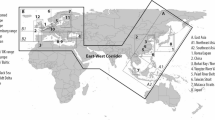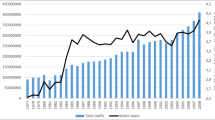Abstract
The paper looks at an intermediate scale of analysis for maritime transportation; the maritime range. Maritime ranges are bounded regions where a set of ports are either in competition, complementary, sharing a common regulatory regime, or having some fundamental geographical commonality. This scale is mostly missing from the research about the structure and organization of maritime transportation focusing on either the port or on the shipping network. The paper proposes a methodology defining maritime ranges bounded by maritime, inter-range, and hinterland boundaries. This methodology is applied to define 28 global maritime ranges representing functional commercial entities generating and attracting maritime traffic.










Similar content being viewed by others
Notes
1982 United Nations Convention on the Law of the Sea.
The Gini coefficient (G) measures the degree of concentration (inequality) of a variable in a distribution of its elements. It ranges between 0, where there is no concentration (perfect equality), and 1 where there is the total concentration (perfect inequality).
The Nearest Neighbor Index (NNI) is expressed as the ratio of the observed mean distance to the expected mean distance. The expected distance is the average distance between neighbors in a random distribution. If the index is less than 1, the pattern exhibits clustering. If the index is greater than 1, the trend is toward dispersion. The area used to calculate the NNI is derived from a 200 km band (100 km on the foreland and 100 km on the hinterland) that follows the coastline of each range.
References
Bernhofen, D., El-Sahli, Z., & Kneller, R. (2016). Estimating the effect of the container revolution on world trade. Journal of International Economics, 98(1), 36–50.
Bhadury, J. (2016). “Panama canal expansion and its impact on east and gulf coast ports of U.S.A.”. Maritime Policy and Management, 43(8), 928–944.
de Langen, P. W. (2007). Port competition and selection in contestable hinterlands : The case of Austria. European Journal of Transport and Infrastructure Research, 7(1), 1–14.
de Langen, P. W. (2015). Governance in seaport clusters. In H. E. Haralambides (Ed.), Port management palgrave readers in economics. London: Palgrave Macmillan.
Ducruet, C. (2013). Ports in a world maritime system: a multilevel analysis. In C. Rozenblat & G. Melancon (Eds.), Methods for multilevel analysis and visualisation of geographical networks. Berlin: Springer.
Ducruet, C., Cuyala, S., & El Hosni, A. (2018). Maritime networks as systems of cities: The long-term interdependencies between global shipping flows and urban development (1890–2010). Journal of Transport Geography, 66, 340–355.
Fraser, D., & Notteboom, T. (2012). Gateway and hinterland dynamics: The case of the Southern African container seaport system. African Journal of Business Management, 6(44), 10807–10825.
Frémont, A. (2007). Global maritime networks: The case of Maersk. Journal of Transport Geography, 15(6), 431–442.
Gekara, V., & Chhetri, P. (2013). Upstream transport corridor inefficiencies and the implications for port performance: A case analysis of Mombasa port and the northern Corridor. Maritime Policy and Management, 40(6), 1–15.
Guerrero, D., & Rodrigue, J.-P. (2014). The waves of containerization: Shifts in global maritime transportation. Journal of Transport Geography, 35, 151–164.
Haezendonck, E., & Langenus, M. (2019). Integrated ports clusters and competitive advantage in an extended resource pool for the Antwerp Seaport. Maritime Policy and Management, 46(1), 74–91.
International Hydrologic Organization (2002) Names and Limits of Oceans and Seas, Fourth Edition, Publication No. 23, Monaco: International Hydrographic Bureau.
Kaluza, P., Kolzsch, A., Gastner, M. T., & Blasius, B. (2010). The complex network of global cargo ship movements. Journal of the Royal Society Interface, 7(48), 1093–1103.
Lee, J.-Y., & Rodrigue, J.-P. (2006). Trade reorientation and its effects on regional port systems: The Korea-china link along the yellow sea Rim. Growth and Change, 37(4), 597–619.
Lee, P. T., Wu, J., Suthiwartnarueput, K., Hu, K., & Rodjanapradied, R. (2016). Factors of waterfront port development. Growth Change, 47, 393–405.
Lemarchand, A., & Joly, O. (2009). Regional integration and maritime range. In T. Notteboom, C. Ducruet, & P. W. de Langen (Eds.), Ports in proximity: competition and coordination among adjacent seaports (pp. 87–98). Aldershot: Ashgate.
Lloyd, C. D. (2014). Exploring spatial scale in geography. Oxford: Wiley.
Marei, N., & Ducruet, C. (2016). The regionalization of maritime networks: Evidence from a comparative analysis of maritime basins. In C. Ducruet (Ed.), Maritime networks: Spatial structures and time dynamics (pp. 330–350). London: Routledge.
McCalla, R. (2004). Hierarchical network structure as seen in container shipping liner services in the Caribbean basin. BelGeo, 4, 407–418.
Merkel, A. (2017). Spatial competition and complementarity in European port regions. Journal of Transport Geography, 61, 40–47.
NEA. (2011). The balance of container traffic amongst European ports, Zoetermeer, Netherlands, R20110190/31637000/SNE/EGR.
Ng, A. K. Y., Ducruet, C., Jacobs, W., Monios, J., Notteboom, T., Rodrigue, J.-P., et al. (2014). Port geography at the crossroads with human geography: between flows and spaces. Journal of Transport Geography, 41, 84–96.
Notteboom, T. (2007). Spatial dynamics in the container load centers of the Le Havre-Hamburg range. Zeitschrift für Wirtschaftsgeographie, 51(1), 108–123.
Pruyn, J. (2016). Will the northern sea route ever be a viable alternative? Maritime Policy and Management, 43(6), 661–675.
Rodrigue, J.-P., & Ashar, A. (2016). "Transshipment hubs in the new panamax era: The role of the Caribbean". Journal of Transport Geography, 51, 270–279.
Rodrigue, J.-P., & Notteboom, T. (2015). Looking inside the box: Evidence from the containerization of commodities and the cold chain. Maritime Policy and Management, 42(3), 207–227.
Van der Lugt, L., De Langen, P., & Hagdorn, E. (2015). Beyond the landlord: Worldwide empirical analysis of port authority strategies. International Journal of Shipping and Transport Logistics, 7(5), 570–596.
Vigarié, A. (1964). Les Grands Ports de Commerce de la Seine au Rhin. Leur Evolution Devant l’Industrialisation des Arrière-pays. Paris: Sabri.
Vigarié, A. (1979). Ports de commerce et vie littorale. Paris: Hachette.
Wilmsmeier, G., & Monios, J. (2016). Container ports in Latin America: Challenges in a changing global economy. In P. T. W. Lee & K. Cullinane (Eds.), Dynamic shipping and port development in the globalized economy (pp. 11–52). London: Palgrave Macmillan.
Xu, M., Li, Z., Shi, Y., Zhang, X., & Jiang, S. (2015). Evolution of regional inequality in the global shipping network. Journal of Transport Geography, 44, 1–12.
Author information
Authors and Affiliations
Corresponding author
Ethics declarations
Ethical approval
The manuscript has not been submitted for publication elsewhere. It represents original work with the relevant sources acknowledged, including data sources.
Additional information
Publisher's Note
Springer Nature remains neutral with regard to jurisdictional claims in published maps and institutional affiliations.
Rights and permissions
About this article
Cite this article
Rodrigue, JP. The geography of maritime ranges: interfacing global maritime shipping networks with Hinterlands. GeoJournal 87, 1231–1244 (2022). https://doi.org/10.1007/s10708-020-10308-y
Accepted:
Published:
Issue Date:
DOI: https://doi.org/10.1007/s10708-020-10308-y




